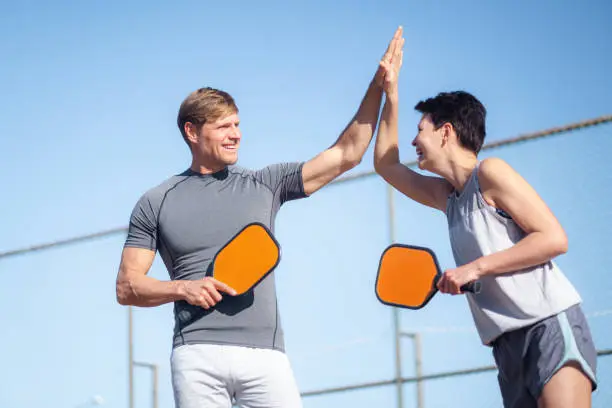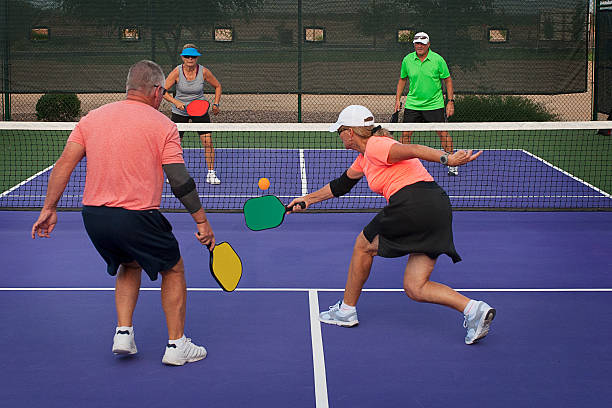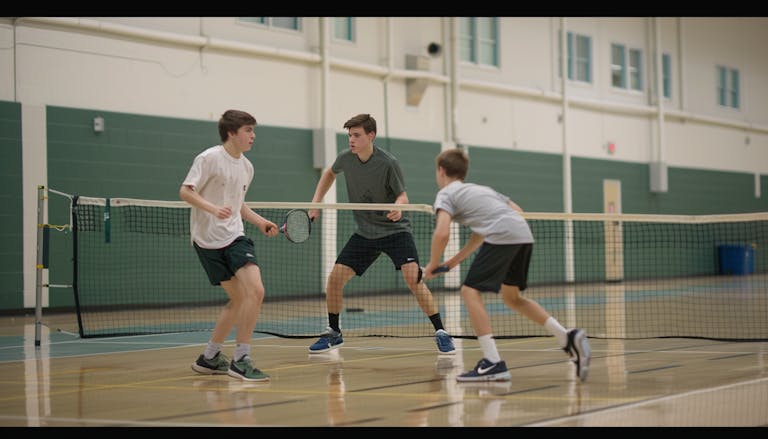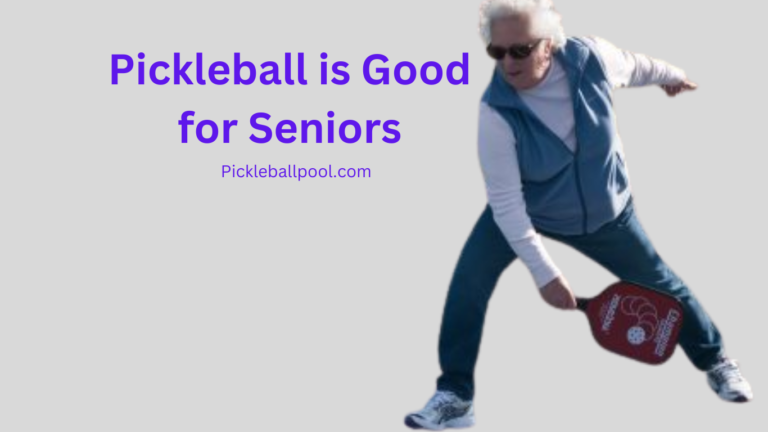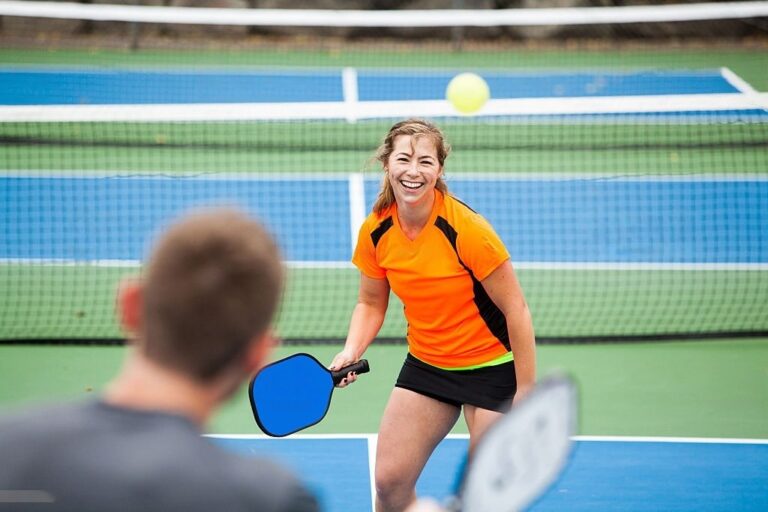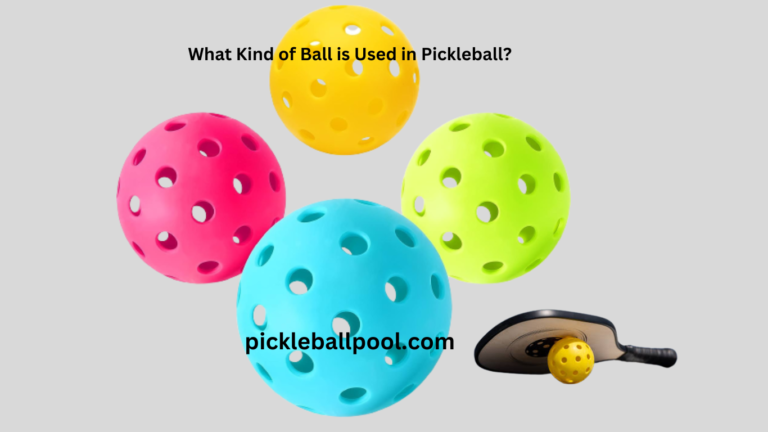Can You Play Pickleball on Artificial Turf? Natural Grass vs. Synthetic Surfaces
Ever tried serving an unreturnable shot or making a quick pivot in pickleball on an unconventional surface, such as artificial turf? It might seem like an unusual combination, but that’s exactly what we are exploring today.
This seemingly offbeat question has sparked numerous lively discussions among enthusiasts, and now it’s time to unveil the mystery. Can you play pickleball on artificial turf?
In this comprehensive guide, we’ll explore the pros and cons of playing pickleball on artificial turf. Thus this article is about the advantages of using artificial turf and how to safely play pickleball on artificial turf.
What is pickleball?
For those new to pickleball, here’s a quick overview. Pickleball is played with a paddle and a plastic ball with holes, similar to a wiffle ball. The court is the same size as a doubles badminton court, with a lower net.
The game is played in doubles or singles. Points are scored by hitting the ball into the opponent’s court. Games go up to 11 points with a two-point margin. Pickleball combines elements of tennis, badminton, and ping pong into one fun, social game.
Why Pickleball is Growing Rapidly
Over the last decade, pickleball’s popularity has exploded. There are now over 4.8 million pickleball players in the U.S. The USA Pickleball Association estimates growth is around 10.5% annually.
There are several reasons driving this growth:
- Fun for all ages: pickleball can be enjoyed by kids, adults, and seniors. The smaller court and lower net make it accessible.
- Social and competitive: Pickleball combines friendly social play with competitive tournaments for all skill levels.
- Good exercise: running around the compact court provides a great workout. Games can raise your heart rate without excessive strain.
- Versatile – Pickleball can be played indoors or outdoors on a variety of surfaces. Minimal equipment is needed.
As more people discover pickleball, demand for places to play continues to rise. This is why many players are now considering artificial turf as an option.
The Role of Playing Surfaces in Pickleball
Having the right playing surface is important in pickleball. The court surface affects footing, ball bounce and gameplay. Some key considerations are:
- Consistency – The ball should bounce in a consistent way on each shot.
- Traction – Players need good traction to move safely without slipping.
- Playability – The surface should accommodate volleys, groundstrokes, and serves.
- Durability: withstand regular play without damage.
- Affordability – Reasonable cost to install andmaintain.
Different surfaces have pros and cons for pickleball in these areas. Let’s look closer at how it stacks up.
What is Artificial Turf?
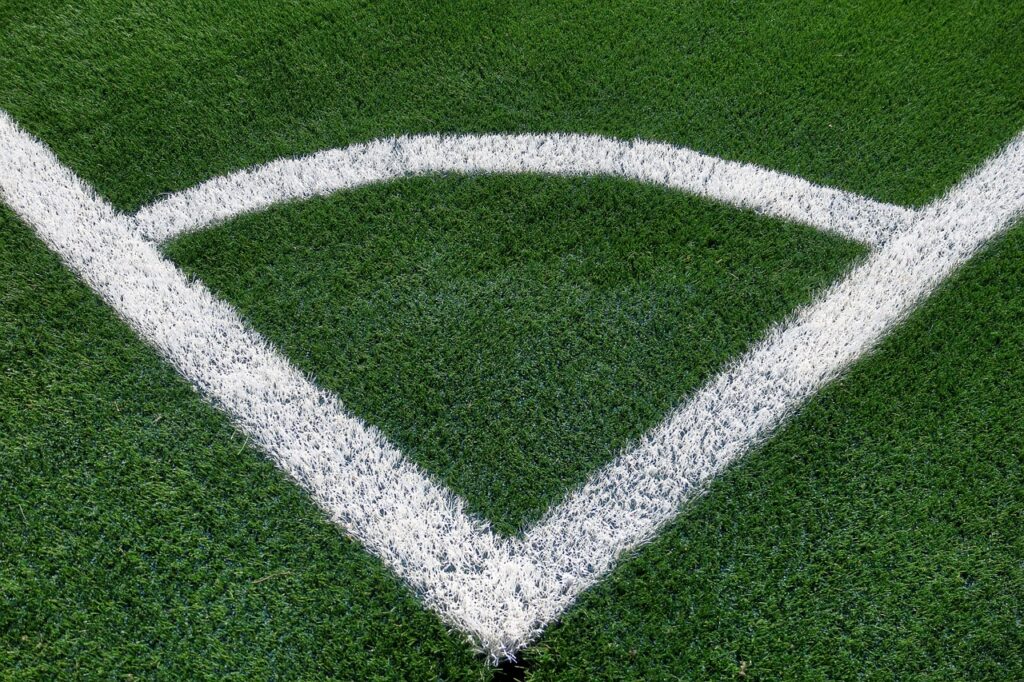
Artificial turf refers to synthetic grass playing fields constructed from synthetic fibers. There are two main types: Polyethylene Turf
This type of turf uses green plastic grass blades made from polyethylene. Infill material, usually crumb rubber, is spread between the blades. The infill improves stability and shock absorption. Hybrid Turf
Hybrid turf combines synthetic grass blades with natural plant fibers spread throughout for a more realistic feel. Cork and coconut coir are often used.
Compared to natural grass, key benefits of artificial grass include:
- All-weather playability.
- More durability under heavy use.
- Lower maintenance requirements.
- Consistent playing conditions.
These traits make artifical grass turf well-suited for many different sports, from football to lacrosse to soccer. But what about pickleball specifically? Let’s dig in.
Can Pickleball Be Played On Grass: Green Fields
Can you play pickleball on artificial turf?
Yes, you can play pickleball on artificial turf. Artificial turf is a great surface for pickleball as it provides a consistent bounce and is less prone to wear than natural grass. It also requires less maintenance and upkeep, so it’s an ideal surface for those who want to play pickleball without worrying about maintaining a natural grass court.
Artificial grass also offers improved traction, which means players won’t slip or slide on the court during their game. This makes it easier to move around the court quickly and helps prevent injuries. Additionally, artificial grass absorbs heat better than natural grass, meaning games can be played in hot weather without players having to worry about the court becoming too hot or uncomfortable.
How Pickleball Plays on Artificial Turf
Pickleball is adaptable to different playing surfaces; however, some work better than others. Here are key factors to consider with Astroturf: Traction
The infill materials in artificial turf provide decent traction for pickleball play. Artificial turf offers a stabilized surface that prevents sliding. There is less risk of injury compared to wet grass or clay courts. Consistency
Synthetic turf delivers a very consistent bounce. The ball reacts the same way on each bounce, allowing players to calibrate their shots. Playability
The smooth, medium-paced surface of turf accommodates all the skills needed in pickleball: volleys, groundstrokes, dinks, and serves. Noise
One downside is fake grass creates a “louder” playing experience. The surface amplifies the popping sound of the pickleball. This is something to consider if noise is a concern. Lifespan
Properly maintained artificial grass can easily last 8-10 years or longer. This makes it a good investment compared to other surfaces that require frequent repairs.
By following these tips, you can maintain the quality of your pickleball experience and ensure your artificial grass pickleball court remains in top condition for years to come.
https://pickleballpool.com/health-benefits-of-playing-pickleball/
Advantages of Playing Pickleball on Artificial Turf
Given these playing characteristics, synthetic grass offers several benefits to playing pickleball:
- Weather-resistant: playable in all conditions; doesn’t get flooded or too hot.
- Consistent surface: the ball bounces uniformly, allowing strategic play.
- Limited maintenance: no need for frequent watering, mowing, or repairs.
- Multi-use fields: lines can be switched out to convert between sports.
- Accessibility: A smooth surface accommodates players with mobility limitations.
- Year-round play: avoid seasonal shut-downs due to extreme weather.
Potential Cons of Artificial Turf
There are also some potential drawbacks to note for a game of pickleball on a turf pickleball court.
- Heat: It can get hotter than grass on sunny days. Requires hydration.
- Abrasiveness – Falls on artificial turf can lead to “turf burns”.
- Grip – Pickleballs can pick up turf fragments, affecting grip and play.
- Cost: higher upfront installation expense compared to clay or poured asphalt.
- Sustainability: limited recycling options; eventually needs replacement.
- Irregular bounces: defects or uneven infill can lead to bad bounces.
Proper construction and maintenance are key to maximizing benefits and minimizing negatives.
How do I safely play pickleball on artificial turf?
To safely play pickleball on an artificial or synthetic turf, keep these tips in mind:
- Stay hydrated. Carry water and drink regularly, even when it is cloudy out.
- Wear sunscreen. Apply broad-spectrum SPF 30+ and reapply as needed.
- Dress properly. Light, breathable clothing reduces heat risks.
- Inspect the court. Look for hazards like holes or debris before play.
- Care for iinjuries:Carry a first aid kit to treat abrasions or cuts.
- Mind the heat: Take breaks and cool off on hot days to avoid heat illness.
Follow these tips for playing pickleball safely on artificial turf.
Building Pickleball Courts using artificial turf
Constructing new courts of pickleball on an artificial turf field involves several steps. Site Layout
- For tournament play, 4-6 courts allow continuous rotations.
- Orient lengthwise north-to-south if possible to reduce sun glare.
Base Construction
- Laser grade and compact the subsurface.
- Install porous crushed stone base 6-8 inches deep for drainage.
Turf Installation
- Select quality turf designed for sports use with UV resistance.
- Seam tape along edges to prevent tears from paddle contacts.
- Include extra turf beyond court borders for full overhang when cutting lines.
Court Lining
- Layout court striping using official dimensions.
- Paint pickleball lines with textured acrylic sports paint.
- Add contrasting colors to designate doubles play area.
Proper planning, base work and installation are essential for functional courts. Quality turf that’s properly maintained keep your turf in top.
How Long Will Artificial Turf Last? Maintaining Artificial Turf
To maximize court longevity and playability, ongoing maintenance is key:
- Inspect regularly – Look for holes, tears or low infill areas needing repair.
- Groom as needed – Use a power broom monthly to spread and freshen infill.
- Deep clean annually – Deep scrub with commercial turf cleaner to break up organic contaminants.
- Spot treat spills – Promptly remove food, gum or chemical spills that can stain.
- Reduce static – Apply an anti-static treatment to minimize ball clinging from static.
- Replenish infill – Top off low areas with new infill to maintain cushioning.
- Repaint lines – Refresh court striping 1-2 times per year to maintain visibility.
Proactive care preserves your investment and provides great playing conditions.
Player Experience: Does Pickleball Bounce On Grass?
So how does it actually feel to play pickleball on an synthetic turf court? Players describe the experience:
- The surface has nice stability for footwork – you don’t feel like you’re going to slide.
- The ball comes off the paddle cleanly without picking up debris like on harder surfaces.
- It plays at a controlled, medium pace allowing you time to get to shots.
- The ball bounce is predictable which lets you plan shots and strategies.
- Softer feel for the joints than asphalt when moving and landing.
Minor adjustments may be needed around footwork, grip and shot placement. But overall most players find artificial grass highly enjoyable for pickleball.
Impact on Gameplay and Strategy
The playing characteristics of artificial turf do influence certain elements of gameplay:
- Slower pace – The ball moves a touch slower allowing more time to react.
- Touch shots – Finesse shots like dinks become easier to control.
- Skip shots – Low skidding returns are more effective. Keeping shots low increases difficulty for opponents.
- Ground game – Groundstrokes have good traction for driving through returns.
- Volleys – Smooth volleys work well, though the surface lacks “crispness” of a hard court.
- Serves – Spin serves grip the surface effectively; precision placement is rewarded.
In general, artificial turf rewards patience, consistency and ball control. Players able to exploit these traits gain an edge.
Grip and Footwear Considerations
To optimize play, use these equipment tips:
- Paddle grip – Opt for higher-tack grip tape that prevents the ball clinging to the face.
- Court shoes – Use athletic shoes with durable outsoles and good lateral support. Herringbone or sawtooth tread patterns work well.
- Cushion – Some players prefer to insert cushioned insoles for comfort during long days of play.
With the right paddle grip and supportive footwear, you can fully enjoy the benefits of artificial turf.
How Pickleball Paddle Grip Size Can Boost Your Game: Grip Right, Smash Hard in Pickleball
How Artificial Turf Compares to Other Pickleball Surfaces
Let’s see how common pickleball surfaces compare to artificial turf: Artificial Turf vs. Grass Courts
Artificial Turf Advantages
- More weather resistant
- Lower maintenance
- No “dead spots” or areas needing repair
Grass Court Advantages
- Feels cooler underfoot
- Softer, more cushioned feel
- Natural aesthetics
Artificial Turf vs. Asphalt/Hard Courts
Artificial Turf Advantages
- Easier on legs and joints
- Added cushioning lessens fatigue
- Lower ambient temperature
Asphalt Court Advantages
- Faster pace and livelier play
- Easier to clean and sweep debris
- Crisper volleys and dinks
Artificial Turf vs. Clay Courts
Artificial Turf Advantages
- More weather resistant
- Daily maintenance not required
- Lower tape wear from dragging feet
Clay Court Advantages
- Sliding possible to extend reach
- One-of-a-kind tactile experience
- Most authentic tennis-like feel
Each surface has pros and cons. Artificial turf provides nice middle ground between soft and hard extremes.
Environmental & Economic Considerations
Installing artificial turf comes with environmental and financial impacts: Sustainability
On the plus side, synthetic turf doesn’t consume water or fuel for mowing once installed. But the manufacturing process and materials do have environmental impacts.
Most fields use some recycled-content materials. But options for recycling the whole system at the end of its life are limited. Fields typically wind up in landfills.
The use and toxicity of infill materials like crumb rubber also raise environmental questions needing further study. Costs
Artificial turf carries a higher upfront cost than poured asphalt or clay. But it can provide longer-term savings when factoring in reduced maintenance and longevity.
Construction costs range from $100K to $500K+, depending on:
- Field size and site conditions
- The type of turf system selected
- Special site preparation needs
- Number of multi-use field line configurations
- Local labour and material rates
Ongoing maintenance costs average $5K to $10K annually.
While not cheap, quality artificial turf is a long-term investment that can serve communities for over a decade.
Notable Artificial Turf Pickleball Installations
Where has artificial turf been successfully used for dedicated pickleball complexes? Here are some top examples: Huntley Park, Abbotsford, BC
This city park in Canada was retrofitted with eight pickleball courts on an existing artificial turf field. Hexagon-shaped portable nets allow conversion for soccer or lacrosse. The LED-lit courts provide much-needed evening capacity. Upper Dublin Indoor Sports Center, Fort Washington PA
To expand winter capacity, this multi-use field house outside Philadelphia installed 4 indoor pickleball courts on an underused artificial turf arena. The venue now runs a dedicated pickleball program from November through March. Central Park Recreation Center, St Petersburg FL
Seeing booming local demand, the city renovated a multi-use field space at this popular rec center with 12 colorful pickleball courts. The artificial turf provides reliable playability in Florida’s hot, humid climate.
These examples demonstrate artificial turf’s ability to meet pickleball’s ongoing growth.
Player Testimonials on Pickleball and Artificial Turf
Don’t just take our word for it. Here’s what players themselves say about competing on artificial turf:
Expert Tips for Optimizing Your Game on Artificial Turf
Here are some pro tips from coaches on excelling when playing on artificial turf:
- Use spin on serves and groundstrokes to take advantage of the surface grip.
- Keep dinks low and tight to the net to reduce pace and reaction time.
- Don’t be afraid to go on offense; well-placed drives won’t fly long.
- Move forward decisively when you have chances to take control of the point.
- Focus on moving efficiently into position rather than relying on raw speed.
With the right strategy adjustments, artificial turf can elevate your skills and court coverage.
Tips For Maintaining Your Artificial Grass Pickleball Court
Here are some pro tips from coaches on excelling when playing on artificial turf:
- Use spin on serves and groundstrokes to take advantage of the surface grip.
- Keep dinks low and tight to the net to reduce pace and reaction time.
- Don’t be afraid to go on offense; well-placed drives won’t fly long.
- Move forward decisively when you have chances to take control of the point.
- Focus on moving efficiently into position rather than relying on raw speed.
With the right strategy adjustments, artificial turf can elevate your skills and court coverage.
Preventing Injuries on Artificial Turf Courts
To help avoid injuries while enjoying the game:
- Choose supportive footwear – Well-cushioned athletic shoes prevent strains and rolls.
- Keep hydrated – Drink plenty of fluids before, during and after play.
- Warm up properly – Dynamic stretches prepare muscles and tendons for activity.
- Respect your limits – Don’t overdo it; take breaks as needed.
- Use sun protection – Cover up and reapply sunscreen; the surface intensifies UV exposure.
- Mind wet weather – Stop play if lighting approaches; wet turf can become slick.
- Address minor injuries – Carry a small first aid kit to treat abrasions, blisters or cuts.
With preparation and attentiveness, you can stay injury-free.
https://pickleballpool.com/best-pickleball-paddles-under-100/
Building Community Around Artificial Turf Pickleball Courts
Installing high-quality dedicated pickleball courts provides a forum for community engagement: Fostering Social Connections
Shared public pickleball facilities allow players to meet others, enjoy friendly competition and develop new relationships. Cross-Generational Appeal
Seeing kids, parents and grandparents playing together builds understanding between age groups. Health and Wellness
The exercise, mental stimulation and social nature of pickleball combine to support holistic wellbeing. Programming and Events
Court facilities can host instructional clinics, competitive tournaments and charity exhibitions involving local businesses and nonprofits. Shared Public Space
Courts in community parks, schools and rec centers provide free or low-cost access to keep the game open to all.
Pickleball is uniquely able to bring people together across many divides. New playing facilities magnify these community benefits.
Calls to Standardize Artificial Turf Pickleball Courts
With growing artificial turf installations, many advocate that standards be developed to ensure consistent play and safety: Court Dimensions
Establishing recommended court sizes, run-off areas and net post placement optimized for pickleball. Surfacing
Defining infill materials, pile height, fiber quality and backing systems for ideal ball response. Lines and Markings
Publishing guidelines for court lines – recommended widths, formats and colors to delineate play areas. Equipment
Specifying net types, ball designs, paddles and other gear to enable fair and enjoyable play. User Safety
Providing construction and maintenance best practices focused on minimizing risks to player well.
Conclusion: Is Artificial Grass A Good Pickleball Surface?
Can you play pickleball on an artificial turf surface? Pickleball and artificial turf can make an awesome combination with the right construction, care and playing strategy. This versatile surface allows more communities to keep growing our beloved sport!
Let me know if you have any other questions about playing this fun game on fake grass courts!
FAQs
Can pickleball be played on synthetic grass?
Typically, Pickleball is played on Synthetic Turf, although an Acrylic Surface can also be used. We are capable of customizing a surface that meets your specific requirements.
What surface can pickleball be played on?
The popularity of asphalt and cement as preferred surfaces for pickleball is largely shaped by the extensive utilization of tennis courts in both sports. Can you play on artificial turf?
If installed properly, premium artificial turf has the durability to endure vigorous activities like soccer or kickball, along with a diverse selection of lawn games including popular ones like cornhole and bocce ball.
What should not be put on artificial turf?
Please refrain from using chewing gum, oils, or adhesives on your artificial grass as they can cause damage.
Can you wear regular tennis shoes on artificial turf?
Yes, but cross trainers with good cushions and support work best. The outsole traction also matters.
How does artificial turf change the feel of play?
It plays at a controlled, medium pace. The surface grips well, letting you add spin. Overall it rewards control and consistency.
Can artificial turf support competitive and pro tournaments?
Absolutely! Many major pickleball tournaments now use temporary or permanent artificial turf courts with great success.
What’s the best way to care for artificial turf courts?
Regular inspection, prompt repairs, frequent grooming, annual deep cleaning and line repainting as needed.

